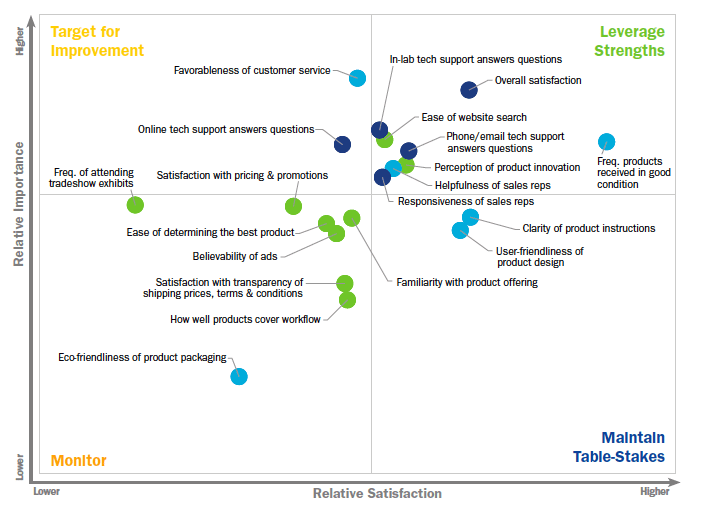A Life Science Supplier’s Guide to Improving the Customer Experience
Our previous articles talked about the importance of customer experience when it comes to winning market share from competitors, and how the industry as a whole is performing on each area of the life scientist customer journey.
With our 2018 Life Science Supplier Customer Experience Benchmark report in hand, you now have a roadmap for knowing where to start looking critically at your customer experience: knowing what touchpoints may be instilling loyalty and which touchpoints might be turning current customers away.
This year, we’ve included a four-quadrant graph for each company, so you can see which areas should be targeted for improvement or monitored for potential problems. The graph also shows which strengths you can leverage to give you differentiation and a competitive advantage, as well as areas you can simply maintain due to already good performance and lower relative importance to customers. Here is an example of what that graph could look like:

This report can help you focus your in-depth market research efforts, so you don’t waste a lot of resources analyzing something that doesn’t need much change.
In addition to individual supplier scores and industry averages, this report also includes data from our 2016 study using the same methodology, so you can track scores and rankings over time. An online interactive report is also available, which allows for more granularity – quickly sort customer scores by region or by scientist segmentation (such as academic or biotech/pharma) or create your own cross-tabs.
By using these tools, you can begin your journey to creating a winning customer experience – one that will differentiate you from the competition and increase customer loyalty. Nevertheless, further in-depth research on individual touchpoints is most likely needed to achieve additional actionable insights.
BioInformatics Inc. also specializes in custom market research projects for life science suppliers. Our customer satisfaction services monitor your customers’ expectations, the extent to which they are being fulfilled, and how you can stay abreast of scientists’ changing needs.
Typical study objectives could include:
Unmet Needs
- Discuss what changes in your company’s products and services the customer desires
- Have customers describe specific performance characteristics and business practices that must be improved
Product Features
- Determine the type and frequency of complaints regarding your products
- Determine customer’s intention to repurchase
Service Issues
- Examine the customer’s satisfaction with competing suppliers on specific types of interactions (such as technical phone support)
- Discuss customer’s satisfaction with your company’s response time
For assistance uncovering deeper insights or for other market data, please visit us at www.bioinfoinc.com or contact us at [email protected].
Inspire loyalty. Win over potential customers. Invest in accurate market research and a winning customer experience.




